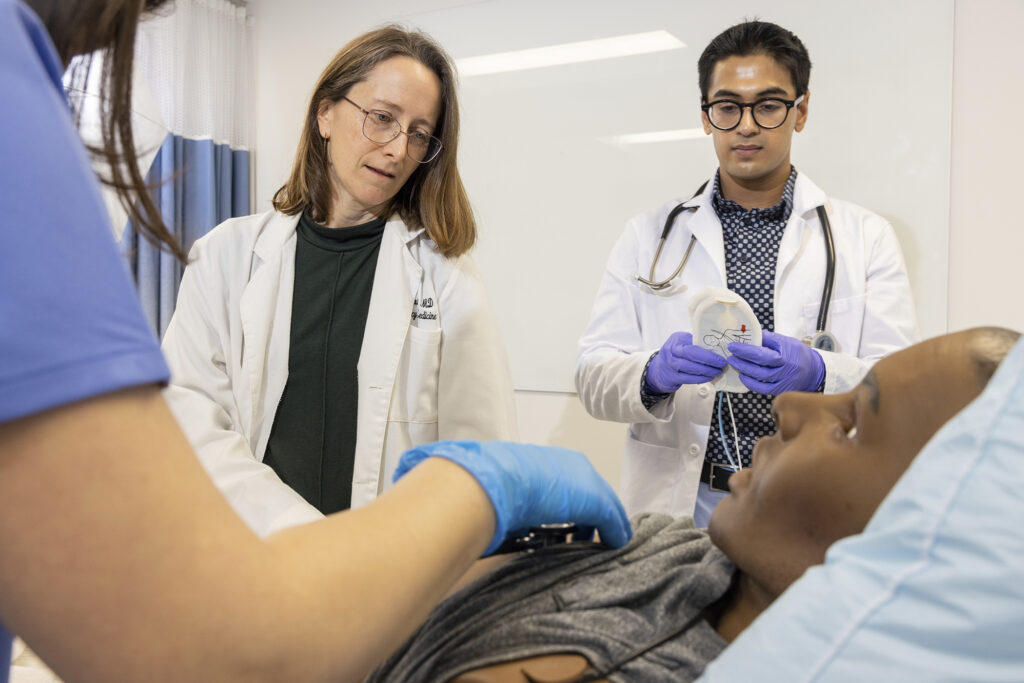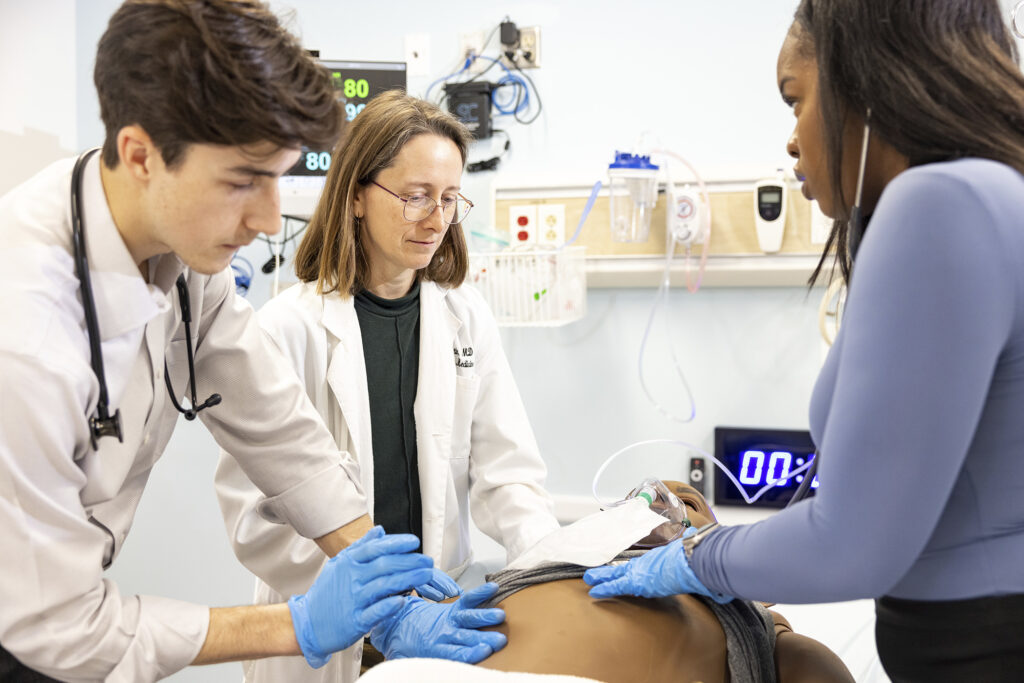A patient lies on a hospital bed. He just fell from his roof and is complaining of chest pain and has developed a cough. He’s covered in sweat and has bruising down his right side. The patient screams out in pain.
Down the hall, a woman is ready to give birth to her baby, while next door, a newborn is struggling to breathe.
It’s not a wild day in the emergency room or a scene from “Grey’s Anatomy,” but a typical day in the simulation center at the Augusta University/University of Georgia Medical Partnership.
And the patients in the center are not real people, but manikins — patient simulators that safely allow medical students to walk through medical emergencies and put their skills to the test to reach a diagnosis.
Dr. Aimee Martin, director of simulation at the Medical Partnership, wears many hats in the center. From writing the simulation exercises to acting as a nurse in a scenario, Martin has her hands in all things sim.

Martin graduated from the University of California, San Diego, with a degree in animal physiology and neuroscience in 1994 before receiving her M.D. from Tulane University in 2000. She went on to complete her emergency medicine residency at Vanderbilt University in 2003.
After completing residency, Martin worked for two years as an active duty physician in the General Leonard Wood Army Community Hospital emergency room in Fort Leonard Wood, Missouri. She then worked as a physician in the emergency department at Piedmont Athens Regional before finding her way to the University of Georgia in 2008, where she worked at the University Health Center.
Martin joined the Medical Partnership in 2015 to teach small group and clinical skills.
“The Medical Partnership was still a very new campus, and we did not yet have a simulation curriculum, but we did have some human patient simulators (manikins),” said Martin. “I was intrigued by the potential learning opportunities for students and began investigating how the manikins worked and how I might use them for teaching.”
Martin also began serving as the faculty advisor for the Emergency Medicine Interest Group and began creating scenarios with the manikin for students to practice performing assessments on patients.
“The students and I really enjoyed the experience, and I began looking into how we could integrate this type of learning into the main curriculum,” said Martin.
In 2017, Martin was promoted to the campus director of simulation and was tasked with developing and implementing a simulation and ultrasound curriculum to be integrated throughout the 4-year undergraduate program.
The Sims
Simulation is an artificial representation of something that could exist in the real world. In medical school, simulation allows students to engage in hands-on learning in patient care without any risk of discomfort or danger to a real patient.
Simulations can mimic any medical emergency. Students have encountered scenarios with heart attack patients, drug overdoses and patients from car accidents.
Simulation center staff members also put a lot of time and effort into making the scenarios as realistic as possible — makeup and prosthetics can be applied to the manikins to look like blood, bruises, cuts and various injuries.
If you visit the simulation center and see a manikin blink or hear them cry out, do not be alarmed—they are quite realistic. Each manikin has a pulse, a chest that rises and falls with each breath and pupils that dilate with light. They can even interact with students via faculty members sitting in a control room. Faculty members seated in the control room can hear the interaction with students and respond back as the patient. They can also make the manikins cough or scream out in pain.
All four years of students at the Medical Partnership use simulation. First-year students are welcomed to the sim center with a scenario in the form of an escape room. It is an interactive way to get new students acclimated to the sim center and the technology. Throughout their first year, M1s will complete three patient care scenarios during their time in the sim center.
The second-year students participate in six patient care scenarios, five of which involve collaborating with the UGA School of Pharmacy faculty and students, and third- and fourth-year students engage in sessions specific to each medical specialty.
When a new simulation scenario is needed, it requires hours of preparation. Martin writes the scripts for the scenarios, meets with faculty members to discuss edits, organizes a test run of the scenario, and debriefs faculty and students before the simulation has even begun.

On the day of a class simulation, the center is buzzing with activity. Martin and her team prepare five sim bays, load the programs for the exercise, and check to ensure all rooms and systems are functioning correctly, and faculty facilitators arrive early to find their stations.
Students work in teams of four when they participate in a simulation exercise, and each sim takes 10-15 minutes. Roles are assigned to each student (recorder, team lead, examiner, etc.) before entering the sim bay. Once the team enters the room, they introduce themselves to the patient, nurse, and other participants who may be in the room (someone acting as a family member, perhaps) and ask the nurse what is known about the patient. After that, it is up to the students how they assess and care for the patient. They take the patient’s history, perform an exam, order diagnostic tests and order interventions to treat or stabilize the patient. The group then decides if the patient needs further care and then presents the patient to a consultant over the phone.
After the scenario is complete, the students meet with the faculty members who were operating the manikin from the control room to discuss the case, how the team performed, and how they can improve. Once the first five groups are done with the exercise, Martin and her team reset every sim, and the next groups enter the bays until all 60 students have finished.
“I hope students gain a better understanding of how knowledge of the foundational sciences, clinical skills, teamwork, leadership skills and oral presentation skills all come into play in the care of their patients,” said Martin. “I also hope it helps them feel more prepared both for their clinical years of training and residency.”
Putting it all together
Martin said she loves her job for many reasons but has a special place in her heart for when a student pulls all their learning together to make a diagnosis.
“I love seeing them put it all together,” said Martin. “When they ask critical questions based on their knowledge of anatomy and pathophysiology, use exam maneuvers they just learned in clinical skills, review diagnostic images and lab results in real-time and learn how to organize their thought processes when determining a diagnosis. I’m honored to play a small part in their journey towards becoming the best physician they can be.”
Martin said she wants people to see past the exterior appearance of sim — these are simply not “dolls” in a play-acting scenario for the students. It’s much more than that.
“These manikins and scenarios represent the students’ future patients with real diseases,” said Martin, “and deserve respect for the important role they have in preparing medical students for caring for patients efficiently, effectively and safely.”


